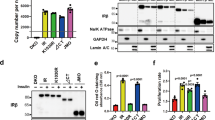Summary
Prolonged exposure of cells to the potent protein synthesis inhibitor cycloheximide terminates in cell death. In the present study we investigated the effect of insulinlike growth factor-1, insulin, and epidermal growth factor on cell death induced by cycloheximide in the confluent MCF-7 cells, and correlated this effect to the inhibition rate of protein synthesis. Cell death was evaluated by measuring either dead cells by the trypan blue dye exclusion test or by the release of lactic dehydrogenase into the culture medium. After 48 h incubation, cycloheximide (10 to 50µg/ml) was shown to induce cell death in a concentration-dependent manner. Insulinlike growth factor-1, at physiologic concentrations (0.2 to 5 ng/ml), reduced this cell death. Insulin at supraphysiologic concentrations (1 to 10µg/ml) mimicked the effect of insulinlike growth factor-1, whereas epidermal growth factor (10 to 50 ng/ml) had no effect. More than 90% of protein synthesis measured by [3H]leucine incorporation was inhibited by 10 to 50µg/ml cyclohexmide. Insulinlike growth factor-1 and insulin at the concentrations that reduced cell death to control level, had no effect on the protein synthesis inhibition rate induced by cycloheximide. These results indicate that inhibition of cell death by insulinlike growth factor-1 does not depend on protein synthesis and may be mediated via a posttranslational modification effect.
Similar content being viewed by others
References
Burton, K. H. A study of the conditions and mechanism of diphenylamine reaction for the colorimetric estimation of deoxyribonucleic acid. Biochem. J. 62:315–323; 1956.
Chan, C. P.; McNall, S. J.; Krebs, E. G., et al. Stimulation of protein phosphatase activity by insulin and growth factors in 3T3 cells. Proc. Natl. Acad. Sci. USA 85:6257–6261; 1988.
Condorelli, G.; Formisano, P.; Villone, G., et al. Insulin and insulinlike growth factor-1 (IGF-1) stimulate phosphorylation of a Mr 175,000 cytoskeleton-associated protein in intact FRTLS cells. J. Biol. Chem. 264:12633–12638; 1989.
Czech, M. P. Signal transmission by the insulin-like growth factors. Cell 59:235–238; 1989.
Furlanetto, R. W.; DiCarlo, J. N. Somatomedin-C receptors and growth effects in human breast cells maintained in long-term tissue culture. Cancer Res. 44:2122–2128; 1984.
Geier, A.; Beery, R.; Haimshon, M., et al. Serum and insulin inhibit cell death induced by cycloheximide in human breast cancer cell line MCF-7. In Vitro Cell. Dev. Biol. 28A:415–418; 1992.
Goldfine, I. D. The insulin receptor: molecular biology and transmembrane signaling. Endocrinol. Rev. 8:235–255; 1987.
Goustin, A. S.; Leaf, E. B.; Shipley, G. D., et al. Growth factors and cancer. Cancer Res. 46:1015–1029; 1986.
Krieg, J.; Hofseetnge, J.; Thomas, G. Identification of the 40S pribosomal protein S6 phosphorylation sites induced by cycloheximide. J. Biol. Chem. 263:11473–11477; 1988.
Martin, D. P.; Schmidt, R. E.; DiStefano, P. S., et al. Inhibitors of protein synthesis and RNA synthesis prevent neuronal death caused by nerve growth factor deprivation. J. Cell Biol. 106:829–844; 1988.
Martin, S. J.; Lennon, S. V.; Bonham, A. M., et al. Introduction of apoptosis (programmed cell death) in human leukemic HL-60 cells by inhibition of RNA or protein synthesis. J. Immunol. 145:1859–1867; 1990.
Osborne, C. K.; Bolan, G.; Monaco, M. E., et al. Hormone responsive human breast cancer in long-term tissue culture: effect of insulin. Proc. Natl. Acad. Sci. USA 73:4536–4540; 1976.
Osborne, C. K.; Monaco, M. E.; Lippman, M. E., et al. Correlation among insulin binding, degradation and biological activity in human breast cancer cells in long-term tissue culture. Cancer Res. 38:94–102; 1978.
Osborne, C. K.; Hamilton, B.; Titus, G., et al. Epidermal growth factor stimulation of human breast cancer cells in culture. Cancer Res. 40:2361–2366; 1980.
Saile, H. D.; Vazquez, J.; Lang, A., et al. A human cell line from a pleural effusion derived from a breast carcinoma. JNCI 51:1409–1413; 1973.
Scher, C. D.; Young, S. A.; Locatell, K. L. Control of cytolysis of Balb/c-3T3 cells by platelet-derived growth factor: a model system for analyzing cell death. J. Cell. Physiol. 113:211–218; 1982.
Searle, J.; Lawson, T. A.; Abbott, P. J., et al. An electron-microscope study of the mode of cell death by cancer-chemotherapeutic agents in populations of proliferating normal and neoplastic cells. J. Pathol. 116:129–138; 1975.
Sellins, K. S.; Cohen, J. J. Gene induction byγ-irradiation leads to DNA fragmentation in lymphocytes. J. Immunol. 139:3199–3206; 1987.
Sorrentino, V.; Battistini, A.; Curatola, A. M., et al. Induction and/or selective retention of proteins in mammalian cells exposed to cycloheximide. J. Cell. Physiol. 125:313–318; 1985.
Tamm, I.; Kikuchi, T. Insulin-like growth factor-1 (IGF-1), insulin, and epidermal growth factor (EGF) are survival factors for density-inhibited, quiescent Balb/c-3T3 murine fibroblasts. J. Cell. Physiol. 143:494–500; 1990.
Wadewitz, A. G.; Lockshin, R. A. Programmed cell death and dying cells synthesize a co-ordinated unique set of proteins in two different episodes of cell death. FEBS Lett. 241:19–23; 1988.
Williams, G. T.; Smith, C. A.; Spooncer, E., et al. Haemopoietic colony stimulating factors promote cell survival by suppressing apoptosis. Nature 343:76–79; 1990.
Wyllie, A. H.; Kerr, J. F. R.; Currie, A. R. Cell death: the significance of apoptosis. Int. Rev. Cytol. 68:251–306; 1980.
Wyllie, A. H. Glucocorticoid-induced thymocyte apoptosis is associated with endogenous endonuclease activation. Nature 284:555–556; 1980.
Wyllie, A. H.; Morris, R. G.; Smith, A. L., et al. Chromatin cleavage in apoptosis: association with condensed chromatin morphology and dependence on macromolecular synthesis. J. Pathol. 142:67–77; 1984.
Author information
Authors and Affiliations
Rights and permissions
About this article
Cite this article
Geier, A., Haimshon, M., Beery, R. et al. Insulinlike growth factor-1 inhibits cell death induced by cycloheximide in MCF-7 cells: A model system for analyzing control of cell death. In Vitro Cell Dev Biol - Animal 28, 725–729 (1992). https://doi.org/10.1007/BF02631060
Received:
Accepted:
Issue Date:
DOI: https://doi.org/10.1007/BF02631060




